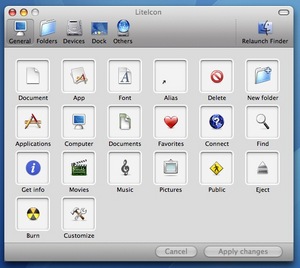I’ve written about a program called Candy Bar before, a program that allows Mac users to change their system icons. I love programs like this, especially on the Mac, especially after having used Linux for a couple years. Why? Because on Linux, there are built-in mechanisms for changing what are called “icon themes” from the default to anything I want.
With Mac, unfortunately, changing anything other than individual icons is pretty much a no-go. Sure, if you want to change the icons of a particular folder, file or application, you can. But what if you want to make a change that affects how every single new folder looks? You can’t, not without a third-party application, or a little knowledge of the system and where it stores files.
But now there’s a program called LiteIcon, and while it isn’t exactly as handy as Candy Bar, it does pretty much the same thing, and does it completely free of change.
When you open LiteIcon, you’ll see six columns of icons, icons for such types as Document, App, Font, Alias, Delete and New Folder. These are General Icons. Above, there are icons for General, Folders, Devices, Dock and Others. Each icon you see can be changed. To change it, all you need to do is drag an icon file from somewhere on your hard drive, and the default type will be replaced by the new one. You can do this for only one icon (in the instance that you like all the regular icons except one), or you can change all of them, for a completely new look.
When you’re done changing the icons in one area (General Icons, for instance), simply move to another tab to change more, or click the button on the bottom of the window to apply your changes. This may take a while, and when you’re finished you’ll need to restart the Finder so that the changes will show up. When you do this, you’ll see all the new icons.
What’s great about LiteIcon is that it affects everything. As you can see from the screen shots, LiteIcon is able to access all the system-wide icons, so whether you’re creating new folders, browsing through your hard drive via the Finder, or mounting/burning a CD, the icons you see will no longer be the same-old default icons. All you need to do is change them here, and whenever an application wants to use one of these icons, the new one will be displayed, at least until you change it back.
Because never fear, removing your new, custom icon theme is as simple as changing it in the first place. In fact, it might even be easier! If you want to change back only a single change, simply Control-click (or right-click, if using a three-button mouse) in the icon you want to restore, and select that option. You’ll be asked for your Administrator password, and when you’re all finished, simply hit the Apply Changes button, restart the Finder, and your old icon is back.
If you want to change the entire system to the way it used to be, all you have to do is select the Restore All Icons option in the File menu. This will replace everything.
Simple!
As I said earlier, LiteIcon isn’t quite as full-featured as a program like Candy Bar. The main reason for this is that Candy Bar takes advantage of something called an iContainer (icon container), which would include all the icons in a particular theme. With that, you simply open Candy Bar, drag the iContainer onto it, and all the icons within the container will replace their default equivalents. It’s much quicker and more convenient, to be honest. However, if cost is the prime motivator, you’ll need to pay the shareware fee to use Candy Bar, while LiteIcon, as mentioned, is completely free.
Despite the added functionality/ease-of-use for Candy Bar, however, LiteIcon is still excellent. It gives every user, not just the techno-savvy, an easy to use, completely free means of changing your icon theme. So grab a copy, along with some icons, and go crazy. You can always undo it.





